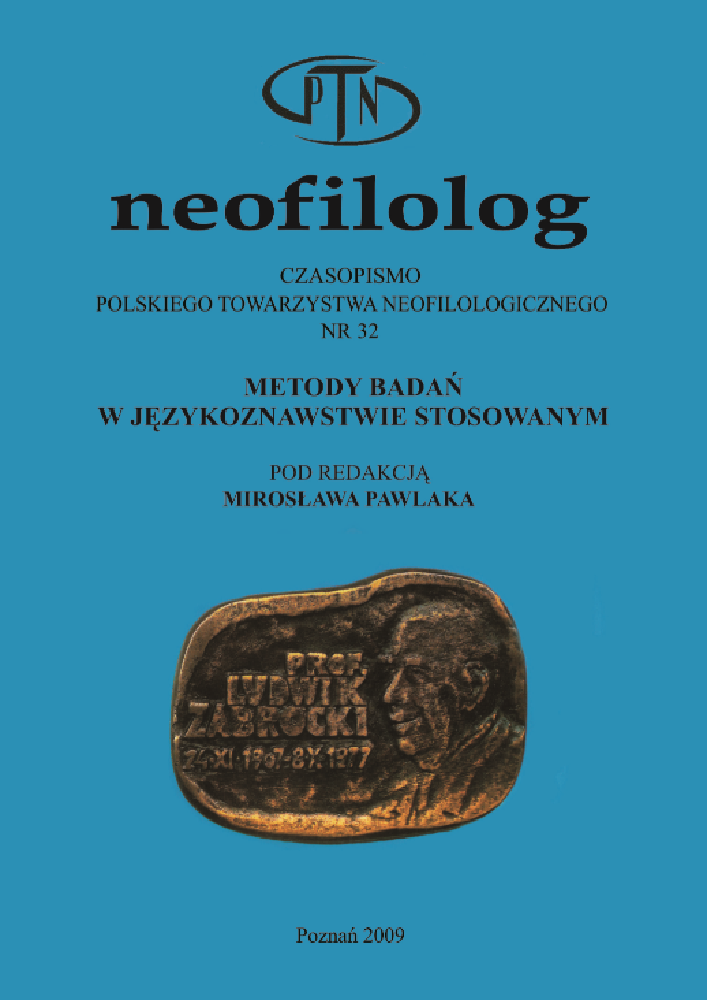Abstract
The present paper presents two theoretical and research traditions concerning second language acquisition and use: psycholinguistic and sociocultural ones. It provides a historical overview of the field of psycholinguistics and second language acquisition studies since the 1950s with its more recent critique
from the representatives of the sociocultural developments in second language theory. The quantitative and qualitative research approaches in contemporary L2 applied linguistics studies are illustrated with a recent study of the acculturation process of Polish immigrants in the United Kingdom done by an MA student.
Literaturhinweise
Allwright, D. i Bailey, K. 1991. Focus on the language classroom: An introduction to language classroom research for classroom teachers. Cambridge: Cambridge University Press.
Andersen, R. 1983. Pidginization and creolization as language acquisition. Rowley, MA: Newbury House.
Arabski, J. 1979. Errors as indications of the development of interlanguage. Katowice: Wydawnictwo Uniwersytetu Śląskiego.
Block, D. 2003. The social turn in second language acquisition. Edinburgh: Edinburgh University Press.
Chomsky, N. 1957. Syntactic structures. The Hague: Mouton.
Chomsky, N. 1959. „A review of B. F. Skinner’s Verbal Behavior”. Language 35. 26-58.
Chomsky, N. 1965. Aspects of the theory of syntax. Cambridge, MA: The M.I.T. Press.
Chomsky, N. 1968. Language and mind. New York: Harcourt, Brace and World.
Corder, S. 1967. „The significance of learners’ errors”. International Review of Applied Linguistics 5. 161-169. de Bot, K., Ginsberg, R. i Kramsch, C. (red.). 1991. Foreign language research in cross-cultural perspective. Amsterdam: John Benjamins.
Dörnyei, Z. 2007. Research methods in applied linguistics. Oxford: Oxford University Press.
Doughty, C. i Williams, J. (red.). 1998. Focus on form in classroom second language
acquisition. Cambridge: Cambridge University Press.
Duskova, L. 1969. „On sources of errors in foreign language learning”. International Review of Applied Linguistics 7. 11-36.
Firth, A. i Wagner, J. 1997. „On discourse, communication and (some) fundamental concepts in SLA research”. Modern Language Journal 81. 285-300.
Gass, S. 1998. „Apples and oranges: Or, why apples are not orange and don’t need to be”. Modern Language Journal 82. 83-90.
Hatch, E. 1983. Psycholinguistics: A second language perspective. Rowley, MA: Newbury House.
Krashen, S. 1981. Second language acquisition and second language learning. Oxford: Pergamon.
Kurcz, I. 1976. Psycholingwistyka. Warszawa: Państwowe Wydawnictwo Naukowe.
Kusiak, M. (red.). 2009. Dialogue in foreign language education. Kraków: Wydawnictwo Uniwersytetu Jagiellońskiego.
Lantolf, J. i Thorne, S. 2006. Sociocultural theory and the genesis of second language development. Oxford: Oxford University Press.
Larsen-Freeman, D. 2004. „CA for SLA? It all depends…”. Modern Language Journal 88. 603-607.
Long, M. H. 1983. „Linguistic and conversational adjustments to non-native speakers”. Studies in Second Language Acquisition 5. 177-193.
Long, M. H. 1991. „Focus on form: A design feature in language teaching methodology”, w: de Bot, K., Ginsberg, R. i Kramsch, C. (red.). 1991. 39-52.
Majer, J. 2003. Interactive discourse in the foreign language classroom. Łódź: Wydawnictwo Uniwersytetu Łódzkiego.
Mańczak-Wohlfeld, E. (red.). 2002. Proceedings of the tenth annual conference of the Polish Association for the Study of English. Kraków: Wydawnictwo Uniwersytetu Jagiellońskiego.
McLaughlin, B. 1987. Theories of second language learning. London: Edward Arnold.
McNamara, T. 1996. Measuring second language performance. London: Longman.
Michońska-Stadnik, A. 1996. Strategie uczenia się i autonomia ucznia w warunkach szkolnych. Wrocław: Wydawnictwo Uniwersytetu Wrocławskiego.
Niżegorodcew, A. 1991. Dyskurs interakcyjny a kompetencja komunikacyjna w języku obcym. Kraków: Wydawnictwo Uniwersytetu Jagiellońskiego.
Niżegorodcew, A. 2002. „Resisting pseudo-communicative language use”, w: Mańczak-Wohlfeld, E. (red.). 2002. 229-237.
Niżegorodcew, A. 2007. Input for instructed L2 learners: The relevance of relevance. Clevedon: Multilingual Matters.
Nowicka, A. 2009. „Situated identities and interaction learning”. W Kusiak, M. (red.). 2009. 63-72.
Osgood, C. i Sebeok, T. 1954. Psycholinguistics: A survey of theory and research problems. Bloomington: Indiana University Press.
Pawlak, M. 2006. The place of form-focused instruction in the foreign language classroom. Poznań – Kalisz: Wydawnictwo Wydziału Pedagogiczno-Artystycznego UAM.
Selinker, L. 1972. „Interlanguage”. International Review of Applied Linguistics 10. 209-231.
Schumann, J. 1978. The pidginization process: A model for second language acquisition. Rowley, MA: Newbury House.
Skehan, P. 1998. A cognitive approach to language learning. Oxford: Oxford University Press.
Smagieł, A. 2008. „The acculturation process of Polish immigrants in the United Kingdom”. Nieopublikowana praca magisterska. Kraków: Uniwersytet Jagielloński.
Zuengler, J. i Miller, E. 2006. “Cognitive and sociocultural perspectives: Two parallel SLA worlds?”. TESOL Quarterly 40. 35-58.
Lizenz
Copyright (c) 2009 Anna Niżegorodcew

Dieses Werk steht unter der Lizenz Creative Commons Namensnennung - Keine Bearbeitungen 4.0 International.
Autoren:
Die Autoren der zur Veröffentlichung in der Zeitschrift Neofilolog angenommenen Texte sind verpflichtet, den Vertrag über die Erteilung einer kostenlosen Lizenz für die Werke mit der Verpflichtung zur Erteilung einer Sublizenz CC auszufüllen, zu unterzeichnen und an die Adresse der Redaktion zurückzusenden.
Gemäß Vertrag erteilen die Autoren auf die in der Zeitschrift Neofilolog veröffentlichten Texte der Adam-Mickiewicz-Universität in Poznań eine nicht exklusive und kostenlose Lizenz und erlauben die Verwendung der Sublizenz Creative Commons Attribution-NoDerivatives 4.0 International (CC BY-ND 4.0).
Die Autoren behalten das Recht zur weiteren freien Verfügung über das Werk.
Benutzer:
Interessierte Onlinebenutzer dürfen die seit 2017 veröffentlichten Werke unter folgenden Bedingungen nutzen:
- Anerkennung der Urheberschaft - die Verpflichtung, zusammen mit dem verbreiteten Werk Informationen über die Urheberschaft, den Titel, die Quelle (Links zum Originalwerk, DOI) und die Lizenz selbst bereitzustellen;
- ohne Schaffung abgeleiteter Werke - das Werk muss in seiner ursprünglichen Form erhalten bleiben, ohne Zustimmung des Autors dürfen keine Studien, beispielsweise Übersetzungen, verbreitet werden.
Die Urheberrechte aller veröffentlichen Texte sind vorbehalten.
Sonstige:
Die Adam-Mickiewicz-Universität in Poznań behält das Recht auf die Zeitschrift als Gesamtheit (Layout, Grafik, Titel, Umschlagsprojekt, Logo usw.).
